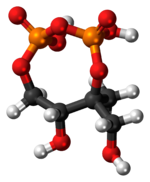Loading AI tools
Chemical compound From Wikipedia, the free encyclopedia
2-C-Methyl-d-erythritol-2,4-cyclopyrophosphate (MEcPP) (also 2-C-Methyl-d-erythritol-2,4-cyclodiphosphate) is an intermediate in the MEP pathway (non-mevalonate) of isoprenoid precursor biosynthesis.[1] MEcPP is produced by MEcPP synthase (IspF) and is a substrate for HMB-PP synthase (IspG).
 | |
 | |
| Names | |
|---|---|
| Systematic IUPAC name
(6S,7R)-2,4,7-Trihydroxy-6-(hydroxymethyl)-6-methyl-1,3,5,2λ5,4λ5-trioxadiphosphocane-2,4-dione | |
| Identifiers | |
3D model (JSmol) |
|
| MeSH | 2-methyl-butan-1,2,3,4-tetraol-2,4-cyclopyrophosphate |
PubChem CID |
|
CompTox Dashboard (EPA) |
|
| |
| Properties | |
| C5H12O9P2 | |
| Molar mass | 278.09 g/mol |
Except where otherwise noted, data are given for materials in their standard state (at 25 °C [77 °F], 100 kPa).
| |
Under conditions of oxidative stress, MEcPP accumulates in certain bacteria.[2] MEcPP releases histone-like proteins from DNA, triggering nucleoid decondensation in Chlamydia trachomatis during the process of terminal differentiation.[3] Abiotic stresses to plants, including wounding and excessive high-light exposure, lead to an increase in MEcPP accumulation in chloroplasts. Transported from the chloroplast to the plant cell nucleus, MEcPP engages in retrograde signalling that leads to the specific induction of nuclear-encoded stress-response genes.[4]
Seamless Wikipedia browsing. On steroids.
Every time you click a link to Wikipedia, Wiktionary or Wikiquote in your browser's search results, it will show the modern Wikiwand interface.
Wikiwand extension is a five stars, simple, with minimum permission required to keep your browsing private, safe and transparent.